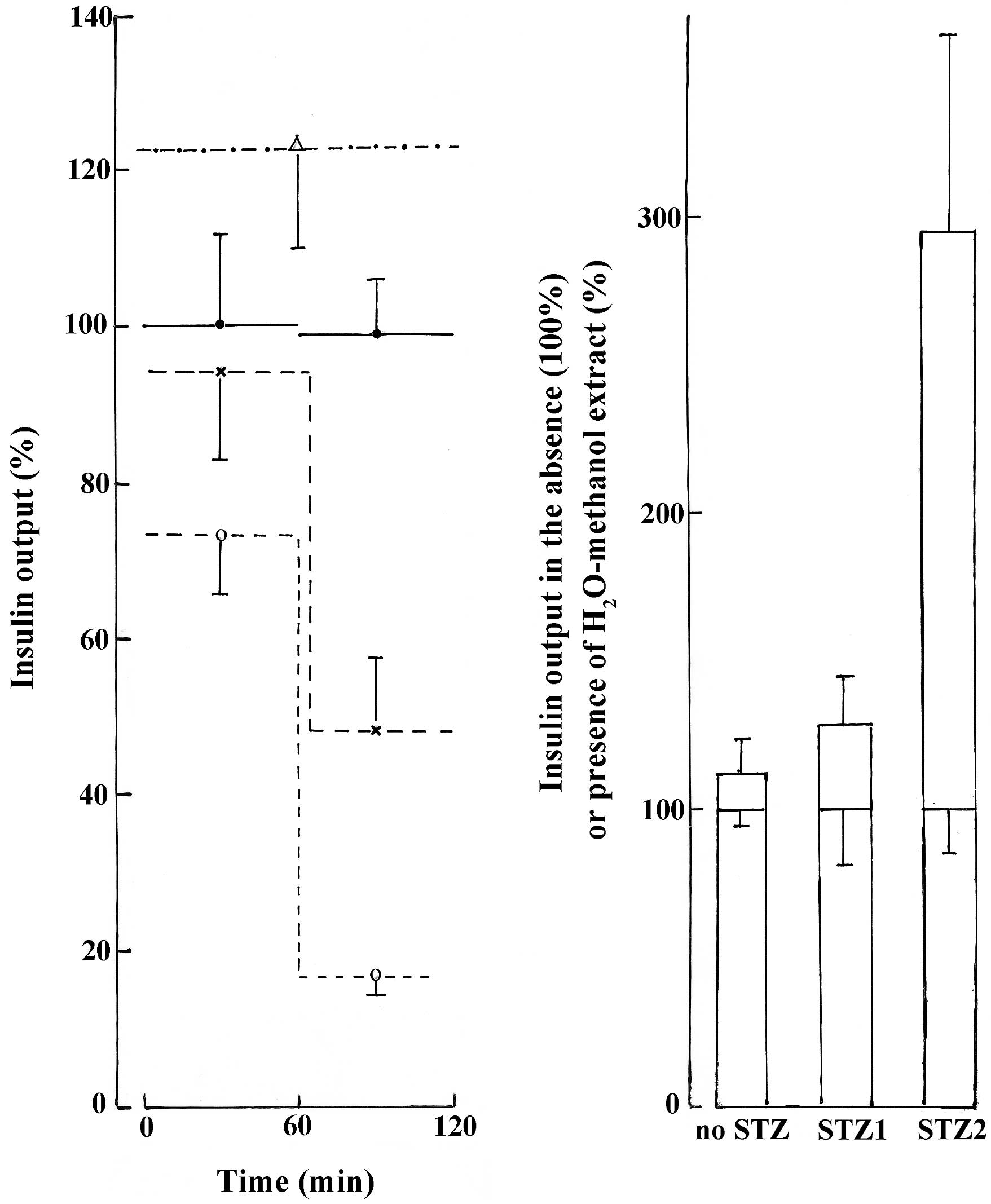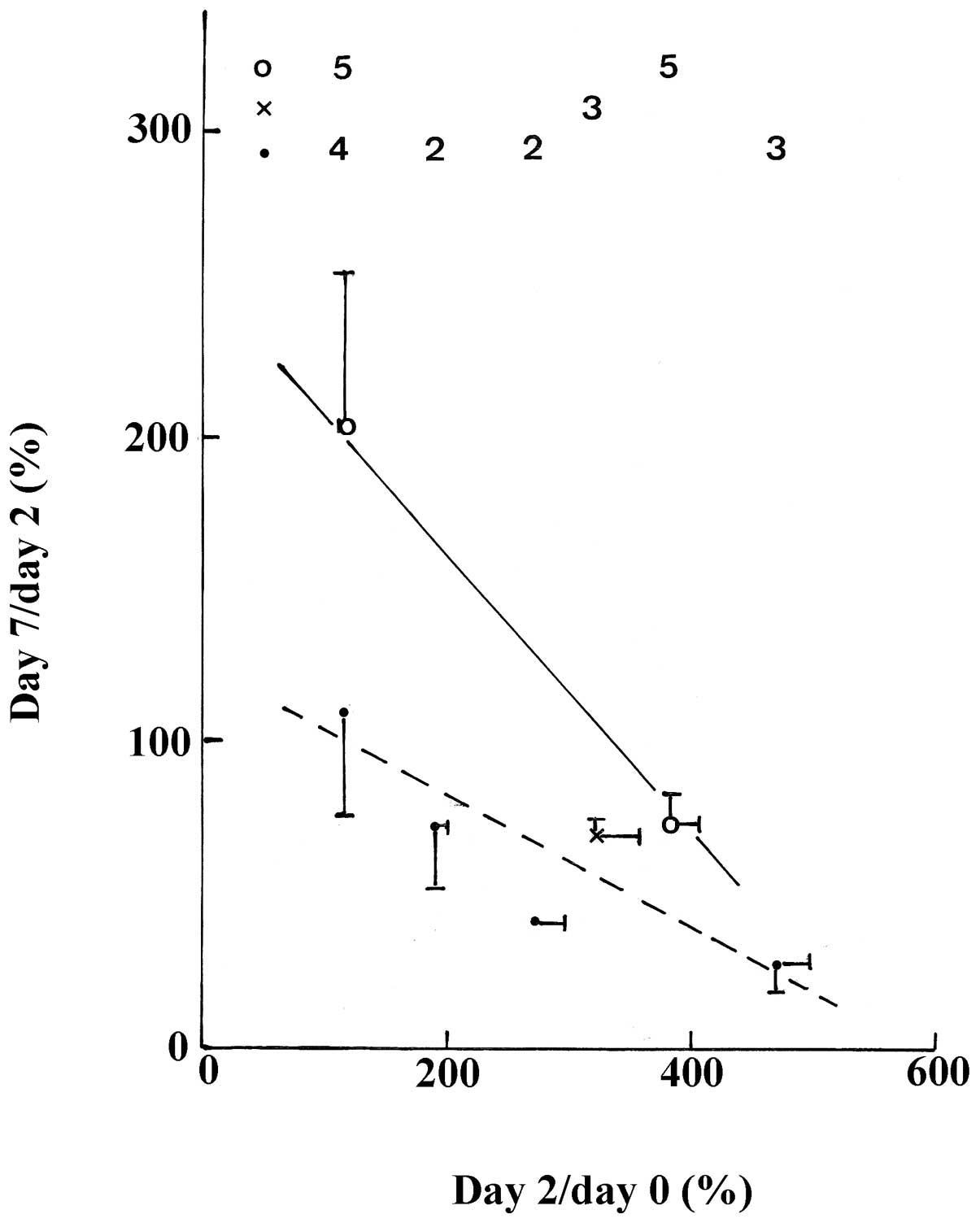Protective action of Citrullus colocynthis seed extracts against the deleterious effect of streptozotocin on both in vitro glucose-stimulated insulin release from rat pancreatic islets and in vivo glucose homeostasis
- Authors:
- Published online on: August 27, 2012 https://doi.org/10.3892/br.2012.5
- Pages: 119-121
Abstract
Introduction
Citrullus colocynthis extracts were reported to have beneficial effects on glucose homeostasis and body weight maintenance, in either alloxan- or streptozotocin (STZ)-induced diabetic rats (1,2). The present study aimed to examine the possible protective action of Citrullus colocynthis extracts against the diabetogenic actions of STZ, since information currently available on the subject is insufficient. (1). To this end, the in vitro effect of an H2O-methanol Citrullus colocynthis seeds extract on the deleterious effect of STZ in glucose-stimulated insulin secretion from isolated rat pancreatic islets was initially examined. Additionally, the protective action of an aqueous extract from Citrullus colocynthis seeds against the STZ-induced impairment of glucose homeostasis was investigated in vivo in rats.
Materials and methods
The aqueous extract of Citrullus colocynthis seeds was prepared as described in a previous study (3). For the hydromethanolic extract, 50 g of seeds were ground and defatted in hexane. This material was then heated and stirred 3 times for 3 h in a water:methanol mixture (30:70). Following filtration and centrifugation, the solution was evaporated until dry, and a hygroscopic red-orange residue (4.5% dry matter) was obtained.
STZ was purchased from Sigma Chemical Co. (St. Louis, MO, USA).
The in vitro experiments were carried out in islet groups (n=8/group), obtained from fed female Wistar rats. Islets were prepared by the collagenase procedure (4) and incubated for two successive periods of 60 min each at 37°C in 1.0 ml of a salt-balanced medium (5) containing 1.0 mg/ml bovine serum albumin, 16.7 mM D-glucose and, as required, STZ (1.9mM) and/or the H2O-methanol extract (500 μg/ml). The insulin content of the incubation media was measured using radio immunoassay (6).
The in vivo experiments were carried out using female Wistar rats injected intraperitoneally with saline (5 ml/kg body wt.) or with crude aqueous extract (90 mg/kg body wt.), either daily for 21 successive days, or only once 24 h prior to the intraperitoneal injection of STZ (0.25 mmol/kg body wt.). The glycemia was measured in blood samples collected from the tail tip, using a glucometer (Accu-Chek).
The results are presented as the mean values (± SEM) with the number of individual determinations (n) or the degree of freedom (df). The statistical significance of differences between the mean values was assessed using the Student’s t-test.
Results
In vitro experiments
The aim of the first series of experiments was to investigate whether the H2O-methanol extract (500 μg/ml) had a protective effect against the deleterious effect of STZ (1.9 mM) on the insulinotropic action of D-glucose (16.7 mM). To this end, the islets were incubated for two successive periods of 60 min each, either solely in the presence of D-glucose or with this hexose, STZ and/or the H2O-methanol extract. Over the two successive 60-min incubations with only D-glucose, the average insulin output during the second incubation remained relatively stable (99.1±6.7%, n=20), compared to the first incubation (100.0±11.9%, n=17). In the presence of the H2O-methanol extract the average insulin output during the first and second incubation periods was 112.4±11.0% (n=39; P>0.34), compared to the mean corresponding values found within the same experiment(s) in the sole presence of D-glucose (100.0±6.2%; n=37) during the same incubation period. During the two successive incubations with STZ, insulin output averaged during the first and second incubation period 73.1±14.1% (n=19; P>0.16) and 14.4±2.0% (n=19; P<0.006), respectively, of the mean reference values recorded in the sole presence of D-glucose, i.e., 100.0±11.9% (n=17) and 100.0±5.9% (n=20). In the presence of STZ and the H2O-methanol extract, the average insulin output during the first and second incubation periods was 94.2±11.5% (n=18) and 42.6±7.1% (n=19), respectively. Consequently, this output was higher compared to the islets exposed to STZ without the H2O-methanol extract, and the difference was highly significant (P<0.001) during the second incubation. These findings are shown in the left panel of Fig. 1, where all results are expressed relative to the mean value found within the same experiment(s) during the first incubation period in islets exposed to 16.7 mM D-glucose. Notably, as shown in the right panel of Fig. 1, during the second incubation the H2O-methanol extract increased to almost three times the D-glucose-induced insulin output in islets exposed to STZ (294.9±51.2%; df =37), distinct (P<0.005 or less) from only 112.4±12.8% (df =74) in islets not exposed to STZ and 128.9±24.4% (df =35) during the first incubation of islets exposed to STZ. The H2O-methanol extract presence/absence ratio in the insulin output was expressed as percentages.
In vivo experiments
The average basal glycemia after overnight starvation in the control rats and those injected with the aqueous extract (90 mg/kg body wt. intraperitoneally) daily for 21 days was 6.28±0.22 mM (n=10) and 6.22±0.21 mM (n=11), respectively, prior to the injection of STZ. Two days after the injection of STZ (0.25 mmol/kg body wt.), the glycemia (after overnight starvation) was increased to 260.4±28.2% (n=24, P<0.001). The Day 2/Day 0 ratio was relatively variable (range, 106.1–523.7%). A negative correlation (P<0.06 or less) was observed between the Day 2/Day 0 ratio and the Day 7/Day 2 glycemia ratio in the control rats injected with saline (5.0 ml/kg body wt.) daily for 21 days and the experimental rats injected with the aqueous extract daily (Fig. 2). For instance, the Day 7/Day 2 ratio decreased in the control rats (P<0.04) from 203.5±50.8% (n=5) to 74.1±9.4% (n=5) when the Day 2/Day 0 ratio increased (P<0.001) from 116.3±2.9% (n=5) to 382.8±23.6% (n=5).
The covariance analysis demonstrated, however, that the slope of the regression line between the Day 7/Day 2 ratio and the corresponding Day 2/Day 0 ratio was 50% lower (P<0.06) in the experimental (−0.2101) compared to the control rats (−0.4531). Moreover, regarding the control and experimental rats with a comparably low (116.3±2.9 and 115.4±2.5%, respectively; n=4–5) or comparably high Day 2/Day 0 ratio (382.8±23.6 and 389.9±51.1%, respectively; n=5 in both cases), the Day 7/Day 2 ratio found in the experimental rats represented no more (P<0.009) than 49.5±8.5% (n=9) of the mean corresponding values present in the control animals (100.0±13.2%; n=10). The absolute glycemia values recorded on Day 7 were also 50% lower (P<0.004) in the experimental rats (8.07±1.19 mM, n=11) compared to the control animals (16.38±2.16 mM, n=10).
As is evident in Fig. 2, there was little to distinguish in terms of the Day 7/Day 2 ratio between the 3 rats injected once with the aqueous extract 24 h prior to STZ administration and the 5 control animals exhibiting a comparable Day 2/Day 0 ratio. However, the mean glycemia at Day 7 tended to be lower (P<0.07) in the former 3 rats (11.67±0.95 mM) compared to the latter 5 animals (19.18±2.39 mM).
Discussion
The present results provide two independent sets of findings demonstrating the protective action of Citrullus colocynthis extracts against the deleterious effects of STZ on both glucose-stimulated insulin secretion from rat-isolated pancreatic islets and glucose homeostasis in rats injected with the β-cytotoxic agent.
In the in vitro experiments, the STZ-induced impairment of glucose-stimulated insulin release was, as expected from prior studies (7,8), markedly more pronounced during the second rather than the first 60-min incubation. Similarly, the protective action of the H2O-methanol extract from Citrullus colocynthis against the STZ-induced alteration of insulin output was, in relative terms, most pronounced during the second incubation period (Fig. 1). Notably, under the present experimental conditions and in the absence of STZ, the H2O-methanol extract failed to induce a statistically significant increase in insulin release at the high concentration of D-glucose (16.7 mM) used in the present experiments.
In the in vivo experiments, the crude aqueous extract of Citrullus colocynthis seeds was injected intraperitoneally for 21 days prior to STZ administration. Results showed that it minimized the severity of hyperglycemia found subsequent to overnight starvation 7 days after STZ administration (Fig. 2). Thus, findings of the in vivo experiments showed the average glycemia 7 days after the STZ injection to be 11.67±0.95 mM (n=3) and 8.07±1.19 mM (n=11), respectively, in rats injected intraperitoneally with the aqueous extract only once 24 h prior to STZ administration and daily for 21 days prior to STZ administration, compared to 16.38±2.16 mM (n=10) in the control rats injected daily with saline for 21 days prior to STZ administration. After 21 daily injections, the difference between the control and experimental rats remained statistically significant, even when allowance was made for the relative severity of hyperglycemia 2 days after STZ administration.
In conclusion, the present study has demonstrated that, in addition to the known beneficial effects of Citrullus colocynthis extracts on glucose homeostasis, when injected in either alloxan- or STZ-diabetic rats, this extract also suppressed the immediate and direct effect of STZ on insulin-producing cells and, by doing so, minimized the perturbation of glucose homeostasis otherwise induced by this β-cytotoxic agent.
Acknowledgements
The authors would like to thank C. Demesmaeker for her secretarial support.
References
|
Zaree AB, Fallahhossini F, Sharifabady R, Norooz zadeh A, Emani H and Ghoshooni H: The effect of Citrullus colocynthis extract on preventing/reducing streptozotocin-induced diabetes in rat. Kowsar Med J. 12:13–20. 2007. | |
|
Dallak M, Al-Khateeb M, Al-Hashem F, Bashir N, Abbas M, Elessa R and Khalil M: In vivo, acute, normohypoglycemic, ant-hyperglycemic, insulinotropic actions of orally administered ethanol extract of Citrullus colocynthis (L.) schrab pulp. Am J Biochem Biotechnol. 5:118–125. 2009. View Article : Google Scholar | |
|
Benariba N, Djaziri R, Zerriouth BH, Boucherit K, Louchami K, Sener A and Malaisse WJ: Antihyperglycemic effect of Citrullus colocynthis seed aqueous extracts in streptozotocin-induced diabetic rats. Met Funct Res Diab. 2:71–76. 2009. | |
|
Malaisse-Lagae F and Malaisse WJ: Insulin release by pancreatic islets. Methods in Diabetes Research. Larner J and Pohl S: Vol I, part B.John Wiley and Sons; New York: pp. 147–152. 1984 | |
|
Malaisse WJ, Maggetto C, Leclercq-Meyer V and Sener A: Interference of glycogenolysis with glycolysis in pancreatic islets from glucose-infused rats. J Clin Invest. 91:432–436. 1993. View Article : Google Scholar : PubMed/NCBI | |
|
Leclercq-Meyer V, Marchand J, Woussen-Colle MC, Giroix M-H and Malaisse WJ: Multiple effects of leucine on glucagon, insulin and somatostatin secretion from the perfused rat pancreas. Endocrinology. 116:1168–1174. 1985. View Article : Google Scholar : PubMed/NCBI | |
|
Golden P, Baird L, Malaisse WJ, Malaisse-Lagae F and Walker M: Effect of streptozotocin on glucose-induced insulin secretion by isolated islets of Langerhans. Diabetes. 20:513–518. 1971. View Article : Google Scholar : PubMed/NCBI | |
|
Golden P, Baird L, Malaisse WJ, Malaisse-Lagae F and Walker MM: Effect of 1-methyl-1-nitrosourea and streptozotocin on glucose-induced insulin secretion by isolated islets of Langerhans. Diabetologia. 12:207–209. 1976. View Article : Google Scholar : PubMed/NCBI |











